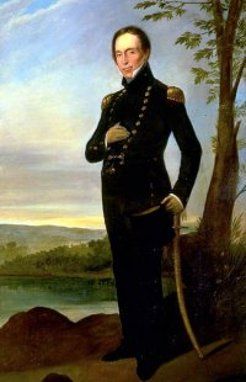

AN AMAZING LINK BETWEEN ELIZABETH BRADSHAW AND PIPER!
by Marjorie Barnard
This article was published in Australian Dictionary of Biography, Volume 2, (MUP), 1967
John Piper (1773-1851), military officer, public servant and landowner, was born on 20 April 1773 at Maybole, Ayrshire, Scotland, the son of Hugh Piper, a doctor. The Pipers were in the main an army family, and Scots only by adoption, having come from Cornwall and before that from Germany. Through the influence of his uncle, Captain John Piper, young John received a commission as ensign in the newly formed New South Wales Corps in April 1791, as his younger brother Hugh was to do in 1799.
John sailed in the Pitt and arrived in Sydney in February 1792 when the infant settlement was still fighting for its life in the face of starvation. Piper was an immediate social success and became a close family friend of John Macarthur.
In 1793 at his own request he was sent on duty to the even more primitive settlement at Norfolk Island, possibly because of an entanglement from which his more discreet friends were anxious to rescue him. While he was away they looked after his interests and secured him a land grant of 110 acres (45 ha) at Parramatta. On the island he received a liberal education in those savage military quarrels which beset the early days of the colony.
In 1795 Piper was promoted lieutenant and returned to the mainland. From 1797 to 1799 he was away on leave. In 1800 he was given the local rank of captain. In the struggle between the corps and Governor Philip Gidley King, of which Macarthur was the ringleader, Piper stood with his friend, and in September 1801 acted as his second in a duel with Colonel William Paterson, his commanding officer. King arrested both Macarthur and Piper, but decided that Piper could be dealt with locally. At his court martial in 1802 he apologized and was acquitted, much to King's disgust.
In 1804 he was again detailed for duty on Norfolk Island. It was fortunate for Piper that he spent the next six years on the island and so was thrown clear of the troubles on the mainland, notably the Rum Rebellion. In September 1804 Lieutenant-Governor Joseph Foveaux left on prolonged sick leave and Piper became acting commandant, with the inadequate extra allowance of 5s. a day. His rule was mild. As one of his charges, Joseph Holt, declared, 'the new Governor had the good will and respect of everyone, for he had always conducted himself as a Christian and a gentleman'. He was promoted to the full rank of captain in November 1806.
By this time Norfolk Island had become an expense rather than an asset, and the British government was planning to close down the settlement and transfer its inhabitants to the mainland or Van Diemen's Land. The duty of beginning to carry out the frequently altered instructions fell to Piper and in it he appears to have exhibited both tact and organizing ability.
In 1810 he returned to Sydney. It is probable that on Norfolk Island he met Mary Ann Shears, the 15-year-old daughter of a convict, and formed an attachment to her that lasted throughout his life. When he sailed for Britain on leave in September 1811 he took her with him, as well as their two little boys, and Sarah, the child of an earlier liaison. He faced a problem connected with both his family and his career, but he preferred Mary Ann and New South Wales to his regiment. Whereas his brother Hugh, now a captain, left the colony with his regiment to continue his army career, John resigned his commission and decided to seek civilian employment in the colony. In 1813 he was appointed Naval Officer in Sydney and arrived back in February 1814. On 10 February 1816 he married Mary Ann, by special licence. She had borne him two more sons while they were away and in due course they had nine more.
His duties included the collection of customs duties, excise on spirits and harbour dues, control of lighthouses and work which is now the province of the water police. The post was very much to Piper's taste and proved very remunerative: with a percentage on all monies collected, his income from it rose to more than £4000 a year.
He bought the property now known as Vaucluse House. In 1816 he was granted 190 acres (77 ha) of land on Eliza Point, now Point Piper, for the site of his official residence. Here he built Henrietta Villa (also called the Naval Pavilion) at the cost of £10,000 and furnished it in the most luxurious style. It was completed in 1822 and became the scene of many sumptuous entertainments.




